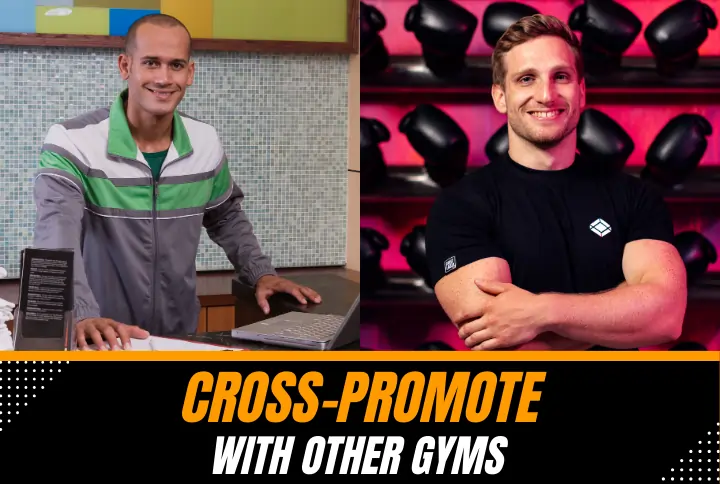
The fitness industry is ultra-competitive. It can be difficult to stand out in such a saturated market, and attracting and retaining members can be a daunting task.
But the right approach to marketing can make things so much simpler.
Over the years I’ve experimented with a range of gym marketing strategies. In the process I’ve developed a deep understanding of what truly works.
This ultimate guide to fitness marketing is a collection of the tactics that are proven to enhance your visibility, boost your engagement and increase your member numbers.
The Key Objectives of this Gym Marketing Playbook
In this playbook we will offer practical, easy-to-implement gym marketing strategies, revealing how your gym can:
- Increase member sign-ups: How to use a mix of online and offline marketing techniques to draw in new members.
- Boost member engagement: The key to retaining members is to keep them active and engaged. We’ll show you how.
- Enhance online visibility: How to use social media, SEO and ads to stand out online and rise above the noise.
- Improve member retention: Increasing customer retention by just 5% can boost profits by 25-95%, so we’ll reveal how to encourage loyalty.
- Adapt to digital trends: How to incorporate the latest technologies and trends into your gym marketing efforts.
13 Proven Strategies for Gym Marketing Success
Ready to learn how to market your gym or fitness business? Let’s dive in.
1. Understand your target market

The first step of gym marketing is to know who you’re marketing to. When you have a clear idea of your target audience, you can develop marketing materials that speak to their needs, wants and situation.
Ask yourself: what does your ideal member look like? You can define your target market by:
- Researching competitors: Understand who your local competitors are, who they’re targeting, the things they’re doing well (which you can replicate), and the things they’re doing not so well (which you can capitalize on).
- Analyzing demographics and psychographics: Look at the age, gender, income and location of existing members. Use surveys and social media to understand their lifestyle preferences, interests and fitness goals.
- Creating member personas: Using the data above, create ‘buyer personas’ - fictional profiles that represent certain ideal members who you can design your marketing materials for.
- Segmenting your market: Divide your target audience into smaller, more specific groups that you can market and advertise to more precisely.
2. Invest in your website
Your website is the hub of your online presence - the thing that all your marketing, advertising, social media and business listings link back to. If you want to maximize the visibility of your fitness business, your site needs to be beautiful, easy to use, quick to load and search engine optimized:
- Responsive design: Ensure the website adjusts smoothly to various screen sizes and devices.
- Fast loading times: Get expert help to ensure your website loads quickly and offers a smooth user experience.
- Intuitive navigation: Make your site easy to navigate and information easy to find through menus and internal linking.
- High-quality visuals: Use professional photos and videos that are optimized for size so that they load quickly.
- Engaging content. Regularly update your website with blog posts, success stories and gym news.
3. Local SEO and Google Business Profile

Local search engine optimization (SEO) is the process of ensuring you come up on the Google results page when someone types in “gym [YOUR LOCATION]” or “gym near me”, which maximizes the visibility of your gym business with the most relevant possible audience – the people who are looking for exactly what you offer.
You can enhance your local SEO by:
- Optimizing your site for local keywords. Include location-specific keywords in your website content and metadata, focusing on the terms potential members might search for, like “best gym in [YOUR CITY].”
- Claiming and verifying your Google Business Profile (formerly Google My Business), which places your business in Google Maps and in the rich (non-text) results. Fill in the relevant info (hours, contact details, services offered), upload content and post regular updates.
- Make sure your business name, address and phone number are consistent across your website, social profiles and online directories.
- Earn backlinks to your site by partnering with local businesses and websites, to improve your authority and search engine ranking.
- Encourage happy members to leave positive reviews on Google, Facebook and other review aggregators, and respond to those reviews. If a review raises concerns, address them in a level-headed and objective way, and apologize where appropriate.
Read more: How do I get more reviews from gym members?
4. Social Media

Social media channels represent an incredible opportunity for gym owners, and should form a key element of any gym marketing plan. From inspirational stories to simply showing beautiful people working out, social media content can help you reach a broader audience while also enhancing member engagement and establishing a sense of community.
Here’s a platform-by-platform breakdown of how your gym can dominate socials:
- Facebook: Share high-quality photos and videos of workouts, classes, and gym events. Utilize Facebook Live for workouts or Q&A sessions to interact with followers in real-time. Create a steady stream of events (special classes, workshops, community events), and use Facebook Ads to target specific demographics.
- Instagram: Post high quality content on your feed, and fun, lo-fi, behind-the-scenes footage on your Stories. Aim for 3-4 posts a week. Use Reels for workout tips and member shoutouts. Collaborate with fitness influencers to gain access to their audiences, and leverage hashtags to increase your visibility.
- YouTube: Upload workout videos featuring your members. Create a fitness challenge series. Produce educational content on workout techniques. Share videos of members sharing their fitness journeys and successes.
- Twitter/X: Ideally you should tweet multiple times a day - try fitness tips, motivational quotes, gym updates - and you should be constantly engaging with other users. Share links to new content you’ve created, like blogs and YouTube videos, and retweet other fitness-focused accounts.
5. Email Marketing
Email marketing is less about the growth of your gym membership numbers than retaining, engaging and upselling current or lapsed members. It’s generally recognized that email marketing has the highest ROI of any marketing method - around $36 for every $1 you spend.
The following strategies can help you craft effective email campaigns:
- Build and segment your email list: Collect email addresses from members, website visitors and people who sign up for free trials. Segment your email list based on source, membership status, workout preferences and engagement levels.
- Craft compelling subject lines: Make your subject lines eye-catching and concise (less than 50 characters). Use action-oriented language.
- Personalize your emails: Use the recipient’s name and tailor the content to their interests and behaviors. Include personalized recommendations, class schedules, discounts and promotions.
- Provide valuable content: Send regular newsletters that compile all your recent content from your website and platforms like Facebook, Instagram and YouTube.
- Include clear calls to action (CTAs): Every email should be sent with a purpose, whether signing up more members, filling classes or simply building a sense of community. Use a clear CTA at the end to tell the recipient what you want them to do.
- Automate your campaigns: Use email marketing software like Mailchimp to send welcome emails for new members, remind members of upcoming classes, and follow up with inactive members.
- Monitor and optimize performance: Track key metrics like open, click-through and conversion rates. Use A/B testing to determine what content, subject lines, and CTAs work best.
Read more: How to Link Mailchimp with your Gym Management Software
6. Events and community engagement

Most gym members like to feel as though they’re part of a community. You can build this environment by hosting events: classes, challenges, social get-togethers and more. Here’s how:
- Host events that resonate with your members: Certain gym members will gravitate towards high-performance events, others to weight loss and fitness goal challenges, and others again to social events. Choose events that align with the vibe of your members.
- Plan them regularly: Build momentum through regular events. Consistency means members can block out their calendars well in advance, boosting attendance.
- Offer free trials and classes: Lower the barrier to entry by giving non-members a no-obligation opportunity to experience your gym.
- Host competitions and challenges: Boost the motivation and engagement of members by hosting weightlifting meets, CrossFit-style tournaments and other fitness challenges. Offer prizes to encourage participation.
- Engage with the broader community: Partner with complementary local businesses like physios, health food stores and sports apparel stores. Sponsor local sports teams and events. Position your gym as a community hub.
- Get social: Host non-fitness-focused events, like Friday night drinks or a group meal at a restaurant. Promote these events (and all the others listed above) on social media. They can prove incredible opportunities to harvest social media content.
Read more: Out-of-the-box ideas for a stronger gym community
7. Referral programs
People trust people, which is why word-of-mouth marketing remains such a powerful way to attract new members. A well-designed referral program will encourage members to spread the good word about your gym. Key strategies to create an effective referral program include:
- Set clear goals: What do you aim to achieve with your referral program? Your goals should be more clearly defined than to just attract new members - they should be SMART: specific, measurable, achievable, relevant and time-bound.
- Offer incentives: An effective referral program needs an enticing carrot - an incentive that makes it worth a member’s time to refer your business. Consider free classes, membership discounts, exclusive merchandise or even cash rewards.
- Simplify the process: Less friction = more participation, so make referring as quick and easy as possible. Use simple online forms and links that members can easily share with their friends.
- Promote your program: Use social media, email marketing, member apps and website pop-ups to ensure that all members are aware of your program and understand how to participate.
- Track and measure success: If your program isn’t generating any referrals, it obviously needs to be tweaked. Set KPIs based on your goals, then track and review this data to enhance the effectiveness of your program. Seek feedback from members too.
- Celebrate referrals: Publicly acknowledge members who frequently refer others. Highlight their efforts in newsletters, social media posts, or even on a referral leaderboard in your gym.
Read more: How to Increase Uptake of Your Gym Refer a Friend Program
8. Digital content
Content is king - it’s the fuel that powers your marketing. High-quality blogs, images, videos and podcasts can be powerful ways to attract, engage and retain gym members.
Blogs are a great way to share your knowledge and establish your gym as a trusted authority in the fitness space. Keyword-filled blogs can also be incredible for your Google ranking. When writing blogs, you should:
- Focus on topics that are relevant to your target audience, whether workout tips, nutrition advice or member success stories. Keyword research can be a helpful source of inspiration.
- Aim to provide value with informative, actionable content that helps readers achieve their fitness goals, such as detailed guides and how-to articles.
- Optimize your blogs for SEO by incorporating relevant keywords, links and metadata.
- Promote your blogs across your social profiles, in newsletters and in private online groups.
Videos form another key content pillar for gyms. They can offer a potential member their first impression of your business, and can say more in a short clip than a blog can say in 1000+ words. When creating videos, you should:
- Start a YouTube channel to reach the widest possible audience. Create and upload workout tutorials, fitness challenges and instructional videos.
- Invest in high-quality production: good lighting, sound and camera equipment, and perhaps even experts to help you produce professional videos.
- Engage with viewers by responding to comments and encouraging people to subscribe to your channel.
- Leverage social media by sharing snippets of your YouTube videos. You can also share rawer, lo-fi footage on socials, making this a cost-effective option.
9. Paid advertising and retargeting
So far we’ve focused almost exclusively on organic marketing methods. But paid advertising still has its place, as it can reach potential members that organic marketing can’t.
In terms of social media, Facebook and Instagram should be areas of focus for your gym advertising efforts, as they are large and particularly visual platforms. Key considerations include:
- Targeting options: Ensure your ads are seen by relevant eyes by utilizing the advanced targeting options on Facebook and Instagram to reach specific demographics, interests and behaviors.
- Ad Formats: Experiment with video, story and carousel ads to find what works best.
- Analytics and optimization: Use Meta Business Suite to track metrics like click-through rates, conversions and cost-per-click, then optimize your campaigns based on the insights you generate.
Google is more or less the gatekeeper of the internet, which makes Google Ads another powerful advertising tool. Consider investing in:
- Search ads: The text ads that appear in Google search results when users search for relevant keywords like “gym near me” or “best fitness center.”
- Display Ads: The banner ads on websites in Google’s Display Network.
- YouTube Ads: The video ads that appear before and during YouTube videos.
10. Analyze and adjust your strategies
We’ve hinted at it already, but digital marketing is all about optimizing your strategies over time, by analyzing data, generating insights, and adjusting strategies based on what you learn.
There are a few compelling reasons to ensure all your marketing decisions are data-driven: you eliminate guesswork and assumptions, you gain a deeper understanding of your members, and you can more effectively identify issues to fix and opportunities to capitalize on.
A few key tools can help your gym to accurately track and measure marketing performance. The most important include:
- Google Analytics: This tool tracks website traffic, including who visits, where they come from and how they interact with your site. You can also track conversions to see how effectively your website converts visitors into members or leads.
- Meta Business Suite: Built for Meta platforms like Facebook and Instagram, this tool allows you to run and optimize ad campaigns, and track engagement metrics for your posts.
- Mailchimp: Create, run and analyze email marketing campaign performance, including open, click-through and conversion rates. Segment your email database then create targeted campaigns based on the interests and behaviors of specific groups.
- CRM software: Client relationship management (CRM) software allows you to keep detailed profiles of every member, including their interaction history, workout preferences and engagement levels, to create personalized marketing that resonates more deeply. At a macro level you can also get a sense of member acquisition and churn rates, and the reasons behind those numbers.
- SEMrush/Ahrefs: Analyze your competitors and optimize your content with these SEO tools, to climb up the Google rankings.
Read more: Setting Standards to Track the Performance of Your Business
11. Retarget potential members
You shop for some new shoes online. In the weeks that follow, you see that same pair of shoes over and over again in display ads, reminding you of your interest. This is retargeting: a powerful strategy that can help you to re-engage potential members who have shown interest in your gym, but haven’t yet converted.
Implement effective retargeting campaigns through:
- Audience segmentation: Segment your audience based on their interactions with your website, such as visiting your membership page, signing up for a free trial, or adding items to their cart.
- Personalized ads: Develop personalized ads that address the specific interests and behaviors of the segmented audience. If a website visitor views your class schedule, show ads highlighting your most popular classes and their benefits.
- Dynamic retargeting: Automatically show personalized ads for the precise services or products that a website visitor viewed, to increase the relevance of your ads and the likelihood of conversion.
- Multiple platforms: Implement retargeting campaigns across the Google Display Network, Facebook, Instagram and more - wherever your audience hangs out on the internet.
- Incentives: Provide special offers or discounts in your retargeting ads to entice potential members to take action. Limited-time offers or exclusive deals can create a sense of urgency and motivate conversions.
12. Cross-promote with other gyms

While it might seem counterintuitive to team up with your competitors, the truth is that many gyms and fitness studios offer complementary services to your own. By partnering with these gyms, you gain access to a new and very relevant target market, which can help you to acquire a large number of new members.
Here’s how to implement a successful cross-promotion strategy:
- Identify complementary gyms: Target gyms that offer a different type of fitness than you do. If your gym has a focus on strength training, you might partner with a yoga or Pilates studio to give your members the flexibility they need to train effectively, or a mixed martial arts training center where they can put their strength to use.
- Create joint promotions: Develop promotions that benefit both gyms, such as discounted membership packages or combined fitness classes. Collaborate on the promotion of these offers and classes too, through social media and email newsletters.
- Host collaborative events: Organize events that bring together the members of both gyms, such as fitness competitions, wellness workshops, charity events or social nights. Choose events that highlight the expertise and facilities of both gyms.
- Share content and resources: Share blog posts, workout videos and fitness tips from your partner gym on your website and social media, and vice versa. Promote each other’s services to attract new followers and potential members from your respective audiences.
- Monitor and evaluate success: Track the performance of your cross-promo efforts through metrics like new member sign-ups, event attendance and social media engagement to ensure they are delivering the desired results.
Gym Marketing: Put In the Work, See the Results
I’ve seen firsthand the transformative power of effective gym marketing strategies. By implementing the fitness marketing plans discussed above, you can make your current members more engaged, you can attract new members, and you can drive serious, sustained growth for your gym.
As any fitness fan knows, you don’t see results unless you put in the work. The best time to start your new gym marketing training regime is now. Let’s get to it.

